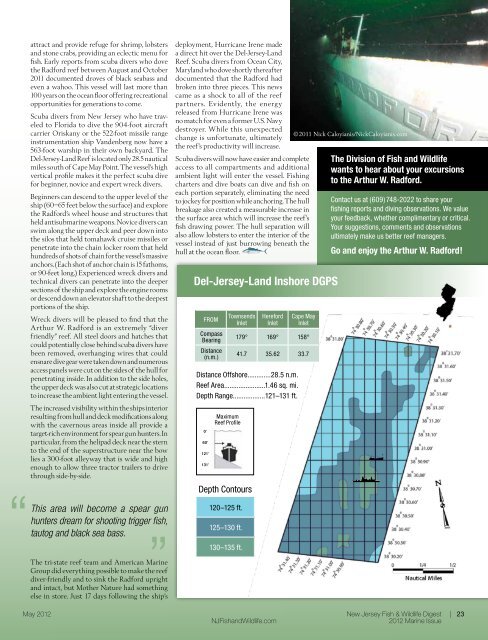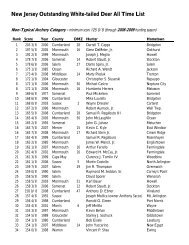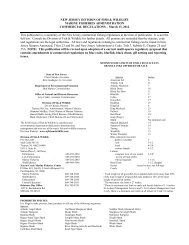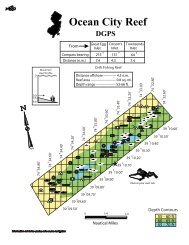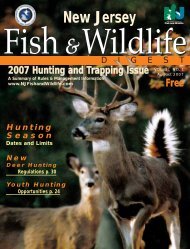Radford reef - Division of Fish and Wildlife
Radford reef - Division of Fish and Wildlife
Radford reef - Division of Fish and Wildlife
Create successful ePaper yourself
Turn your PDF publications into a flip-book with our unique Google optimized e-Paper software.
attract <strong>and</strong> provide refuge for shrimp, lobsters<strong>and</strong> stone crabs, providing an eclectic menu forfish. Early reports from scuba divers who dovethe <strong>Radford</strong> <strong>reef</strong> between August <strong>and</strong> October2011 documented droves <strong>of</strong> black seabass <strong>and</strong>even a wahoo. This vessel will last more than100 years on the ocean floor <strong>of</strong>fering recreationalopportunities for generations to come.Scuba divers from New Jersey who have traveledto Florida to dive the 904-foot aircraftcarrier Oriskany or the 522-foot missile rangeinstrumentation ship V<strong>and</strong>enberg now have a563-foot warship in their own backyard. TheDel-Jersey-L<strong>and</strong> Reef is located only 28.5 nauticalmiles south <strong>of</strong> Cape May Point. The vessel’s highvertical pr<strong>of</strong>ile makes it the perfect scuba divefor beginner, novice <strong>and</strong> expert wreck divers.Beginners can descend to the upper level <strong>of</strong> theship (60–65 feet below the surface) <strong>and</strong> explorethe <strong>Radford</strong>’s wheel house <strong>and</strong> structures thatheld antisubmarine weapons. Novice divers canswim along the upper deck <strong>and</strong> peer down intothe silos that held tomahawk cruise missiles orpenetrate into the chain locker room that heldhundreds <strong>of</strong> shots <strong>of</strong> chain for the vessel’s massiveanchors. (Each shot <strong>of</strong> anchor chain is 15 fathoms,or 90-feet long.) Experienced wreck divers <strong>and</strong>technical divers can penetrate into the deepersections <strong>of</strong> the ship <strong>and</strong> explore the engine roomsor descend down an elevator shaft to the deepestportions <strong>of</strong> the ship.Wreck divers will be pleased to find that theArthur W. <strong>Radford</strong> is an extremely “diverfriendly” <strong>reef</strong>. All steel doors <strong>and</strong> hatches thatcould potentially close behind scuba divers havebeen removed, overhanging wires that couldensnare dive gear were taken down <strong>and</strong> numerousaccess panels were cut on the sides <strong>of</strong> the hull forpenetrating inside. In addition to the side holes,the upper deck was also cut at strategic locationsto increase the ambient light entering the vessel.The increased visibility within the ships interiorresulting from hull <strong>and</strong> deck modifications alongwith the cavernous areas inside all provide atarget-rich environment for spear gun hunters. Inparticular, from the helipad deck near the sternto the end <strong>of</strong> the superstructure near the bowlies a 300-foot alleyway that is wide <strong>and</strong> highenough to allow three tractor trailers to drivethrough side-by-side.“ „This area will become a spear gunhunters dream for shooting trigger fish,tautog <strong>and</strong> black sea bass.The tri-state <strong>reef</strong> team <strong>and</strong> American MarineGroup did everything possible to make the <strong>reef</strong>diver-friendly <strong>and</strong> to sink the <strong>Radford</strong> upright<strong>and</strong> intact, but Mother Nature had somethingelse in store. Just 17 days following the ship’sdeployment, Hurricane Irene madea direct hit over the Del-Jersey-L<strong>and</strong>Reef. Scuba divers from Ocean City,Maryl<strong>and</strong> who dove shortly thereafterdocumented that the <strong>Radford</strong> hadbroken into three pieces. This newscame as a shock to all <strong>of</strong> the <strong>reef</strong>partners. Evidently, the energyreleased from Hurricane Irene wasno match for even a former U.S. Navydestroyer. While this unexpectedchange is unfortunate, ultimatelythe <strong>reef</strong>’s productivity will increase.Scuba divers will now have easier <strong>and</strong> completeaccess to all compartments <strong>and</strong> additionalambient light will enter the vessel. <strong>Fish</strong>ingcharters <strong>and</strong> dive boats can dive <strong>and</strong> fish oneach portion separately, eliminating the needto jockey for position while anchoring. The hullbreakage also created a measurable increase inthe surface area which will increase the <strong>reef</strong>’sfish drawing power. The hull separation willalso allow lobsters to enter the interior <strong>of</strong> thevessel instead <strong>of</strong> just burrowing beneath thehull at the ocean floor.Del-Jersey-L<strong>and</strong> Inshore DGPSFROMCompassBearingDistance(n.m.)Distance Offshore.............28.5 n.m.Reef Area.......................1.46 sq. mi.Depth Range..................121–131 ft.0'60'121'131'TownsendsInletMaximumReef Pr<strong>of</strong>ileDepth Contours120–125 ft.125–130 ft.130–135 ft.HerefordInlet©2011 Nick Caloyianis/NickCaloyianis.comCape MayInlet179° 169° 158°41.7 35.62 33.7The <strong>Division</strong> <strong>of</strong> <strong>Fish</strong> <strong>and</strong> <strong>Wildlife</strong>wants to hear about your excursionsto the Arthur W. <strong>Radford</strong>.Contact us at (609) 748-2022 to share yourfishing reports <strong>and</strong> diving observations. We valueyour feedback, whether complimentary or critical.Your suggestions, comments <strong>and</strong> observationsultimately make us better <strong>reef</strong> managers.Go <strong>and</strong> enjoy the Arthur W. <strong>Radford</strong>!May 2012 New Jersey <strong>Fish</strong> & <strong>Wildlife</strong> Digest | 23NJ<strong>Fish</strong><strong>and</strong><strong>Wildlife</strong>.com2012 Marine Issue


